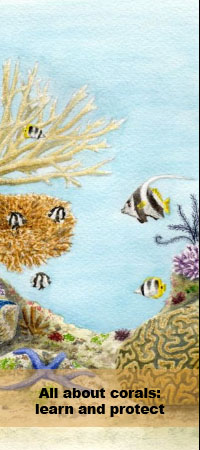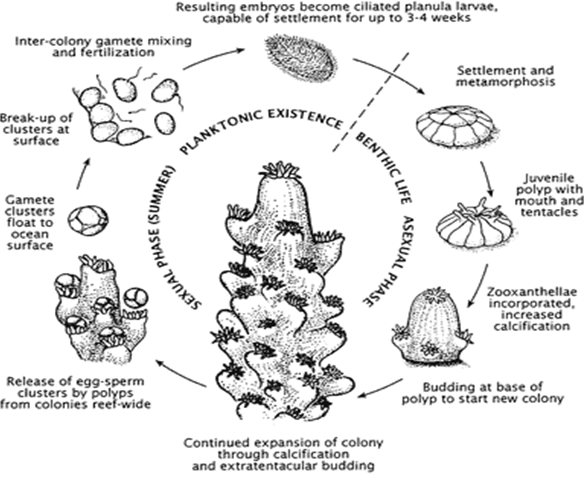|
Coral polyps can feed in two different ways and the method in which they feed depends largely on whether they host zooxanthelle symbionts.
Corals without zooxanthelle (ahermatypic corals) feed exclusively on prey found in the water using their tentacles and nematocysts (stinging cells). When live prey, such as plankton, passes over the coral polyp, it releases barbed harpoon-like nematocysts to stun the prey so that it can be pulled back towards its mouth by its tentacles. As well as feeding on live prey captured by their tentacles and nematocysts, coral polyps’ can also feed on dissolved organic matter which they absorb from the surrounding ocean waters and suspended particles and detritus matter that become trapped in their mucus layer. These feeding behaviours are generally carried out at night and are collectively known as heterotrophic feeding.
Corals that host zooxanthelle (hermatypic corals) rely heavily on autotrophic feeding activity which involves the zooxanthelle and sunlight. As the zooxanthelle photosynthesis they use the carbon dioxide respired by the polyp animal, water and sunlight to produce high energy nutrients and oxygen which they then share with their coral host. This energy can provide the full needs of the zooxanthelle as well as up to 95% of energy needed by the coral. As well as gaining energy from the zooxanthelle, corals hosting zooxanthelle will also carry out heterotrophic feeding (described above) at night however this form of feeding activity is limited.
Coral gender and reproduction
Many species of coral are hermaphrodites meaning they have both male and female reproductive organs and can produce eggs and sperm. However some coral species have separate male and female polyps. Coral colonies can be comprised of solely hermaphrodites, single sex individuals or a mix or male, female and hermaphrodite corals.
Coral polyps reproduce sexually and asexually. Sexual reproduction can happen in two ways – broadcast spawning and brooding. Broadcast spawning happens when coral communities release sperm (gametes) and eggs into the water column simultaneously. When the sperm meets and externally fertilises an expelled egg, a larva, known as a planula, is formed. This planula continues to float in the ocean until a suitable hard surface for colonisation is found. If only male gametes are released, female corals may take in the sperm and fertilise their eggs internally releasing the planula though their mouth when it is at an advanced stage of development. This is known as brooding.
After the planula has found a suitable place to settle, it will go through a period of metamorphosis to become a juvenile polyp. This juvenile polyp will then grow and reproduce over time to develop a new coral colony. The growth of this new colony, although initiated through sexual reproduction, may occur as a result of asexual reproduction also known as budding. Budding occurs when the ‘founding’ coral polyp divides, either from its oral disk (intra-tentacular) or from its base (extra-tentacular), to produce a genetically identical replica of itself. These new coral polyps and the ‘founding’ coral may later reproduce sexually though coral spawning events.
When do coral spawning events occur?
Broadcast spawning events happen once or twice a year and are believed to be triggered by the lunar cycle, diurnal cycle and rising water temperatures. To prevent hybridisation, spawning times vary between species. As a result, different species of coral will release their gametes on different days, usually over a period of one week. Polyp sperm takes approximately 3-4 months to mature while the development of eggs takes between 6-22 months depending on species.
|
|
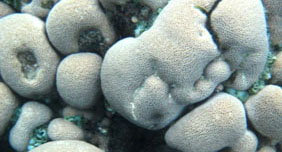
The top of corals is covered with a mucus layer. © Pierre Fidenci
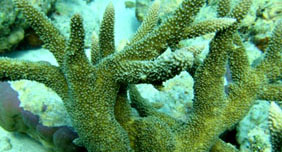
Coral involves the zooxanthelle and sunlight for feeding. © Pierre Fidenci
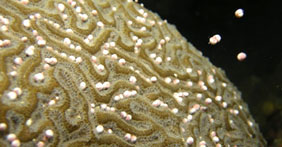
Coral spawning. © NOAA
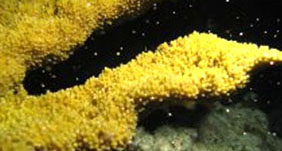
Tiny pink egg/sperm released from an elkhorn coral. © SEFSC
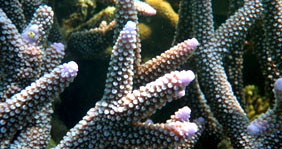
Broadcast spawning events happen once or twice a year. © Endangered Species International
|

